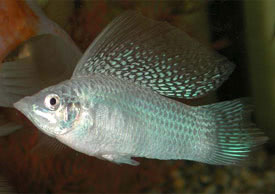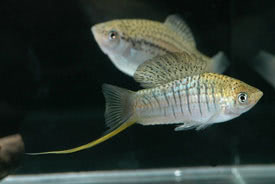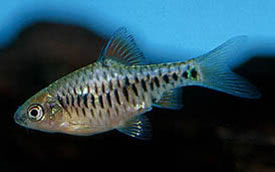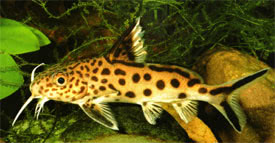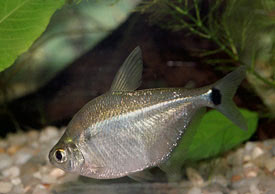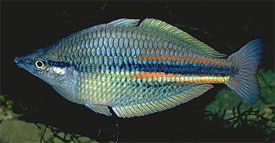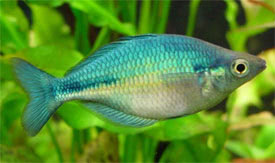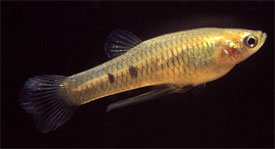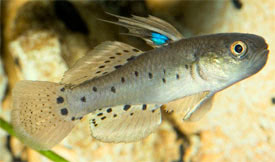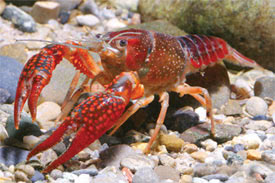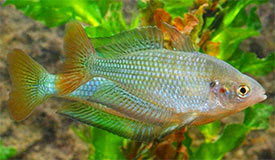Pseudetroplus maculatus - Orange Chromide
 Magyarul / Hungarian
Magyarul / Hungarian

 Magyarul / Hungarian
Magyarul / Hungarian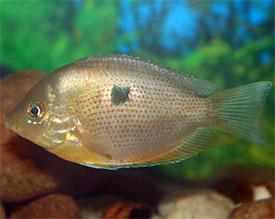

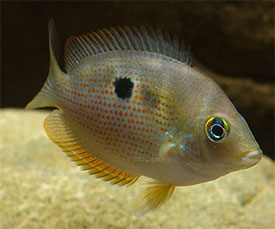
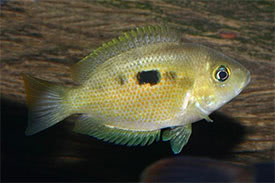
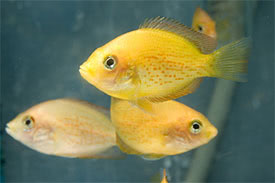
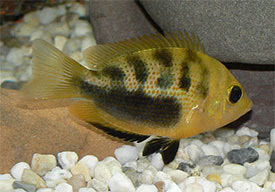
- Scientific name: Pseudetroplus maculatus
- Synonyms: Etroplus maculatus (Bloch; 1795), Chaetodon maculatus (Bloch; 1795), Glyphisodon kakaitsel (Lacepéde, 1802)
- Common name: Orange Chromide
- Group: Brackish fish
- Distribution: Asia; peninsular India and Sri Lanka
- Size: 7-8 cm
- Biotope: Found in river estaurines, where freshwater meets the saltwater, or in coastal lagoons. In Sri Lanka it can be found in freshawater lakes, although it appears to have been introduced intentionally.
- Social behavior: Quite peaceful, unless breeding, they can be kept in a community tank too, but they deserve a one-species aquarium. They may predate on smaller fishes. This is a gregarious species so they should be kept in a small group.
- Diet: Omnivorous; In nature it eats aufwuchs and filamentous algae, but it has been observed acting as a cleaning fish for its congener Etroplus suratensis consuming parasites from its body. In aquarium they feed on live and frozen foods, but particularly bloodworm is their favorite food. Dried foods should contain a significant proportion of vegetable matter (such as spirulina).
- Breeding: Quite hard
- Tank: Minimum 120 litres
- Population: 8-10 fish for 300 litres
- Decoration: The substrate should be small gravel or coral sand, and build hiding places from rocks and roots. Use aquatic plant only that can survive the brackish water. It is a tender fish, the water quality must be excellent, so weekly water changes shouldn't be neglected.
- Temperature: 20-29 °C
- pH: 7.0-8.5
- Hardness: 10.0-20.0 dGH
- Lifespan: 5-8 years
Description: Orange Chromide has an oval shaped and highly compressed body. The body color can vary, but should generally be orange in color, this can range from quite pale orange to red. Wild fish are rather olive-green in color with 1-3 dark blotches just above midbody. When frightened or stressed short bars may appear in the upper portion of the body with a solid dark posteroventral patch. The majority of body scales having an orange-red centre, and these numerous horizontal lines of deep golden spots giving the spotted pattern of the fish. The belly is light orange while the fins are transparent with an orange tint. Males sometimes have greyish pelvic and black anal fins. This species can be maintained in fresh or brackish water as long as acidic conditions are avoided, but if you add a tablespoon of salt to every 10 litres of their water, they will be more colorful and more resistant against fungal infections. Wild caught fish are rarely-seen in the aquarium hobby although selectively-bred ornamental strains are widely-available, which have a solid yellow-orange colour pattern with no dark elements.
It is hard to distinguish the sexes. Males may have more vivid colorations.
Observations of wild fish in Sri Lanka suggest that there are two spawning periods each year represented by the dry pre-monsoonal (December to April) and monsoonal (June to September) seasons, when water salinity increases and water-flow decreases, as the monsoon season is dry in parts of Sri Lanka. During this periods the water is less turbid, hence the adults have improved visual contact with their fry. The breeding pair usually select areas of dense vegetation as spawning site. Pseudetroplus maculatus is a biparental substrate spawner which forms temporary pair bonds, where both parents taking care of eggs and fry. In the aquarium it's best to purchase a group of fish and allow them to select their own partners. Orange Chromide are sexually mature at about 8 months of age, when they are almost reach their full length. The pair will select a smooth surface as spawning site, usually a flat rock, a clay pot, or even the aquarium glass, where the female deposits her 2-3 mm long greyish eggs. The eggs have short filaments permitting a degree of movement when the parents fan them with their fins. The number of the eggs can vary between 200 and 300. They hatch in approximately 2 days at a temperature of 27°C, and the larvae become free-swimming in another 2-3 days. Prior to hatching the adults excavate a number of nursery pits in the substrate surrounding the spawning site and the fry are moved between these until their yolk sacs are absorbed. In the first days young orange chromides feed on mucous coating of their parents body (likewise Discus fish). Parental care can be highly-extended and a pair may even continue to defend their fry until they are almost as large as themselves. Some breeders prefer to remove the eggs prior to hatching and place them in a separate tank, where they hatch the eggs artificially by placing an air-stone near the eggs that can gently move the water and remove the white eggs by hand. Free-swimming fry are readily accept Artemia nauplii and their growth rate is fast.
Sources:
http://www.seriouslyfish.com/species/etroplus-maculatus/
http://www.fishbase.org/summary/8703
https://en.wikipedia.org/wiki/Orange_chromide
https://www.theaquariumwiki.com/Etroplus_maculatus
http://aquaticnation.org/library/Lib_Cich_sp_Etroplus_maculatus.php
http://www.aquariumlife.net/profiles/asian-cichlids/orange-chromide/100053.asp
http://www.seriouslyfish.com/species/etroplus-maculatus/
http://www.fishbase.org/summary/8703
https://en.wikipedia.org/wiki/Orange_chromide
https://www.theaquariumwiki.com/Etroplus_maculatus
http://aquaticnation.org/library/Lib_Cich_sp_Etroplus_maculatus.php
http://www.aquariumlife.net/profiles/asian-cichlids/orange-chromide/100053.asp
Hasonló vízparamétereket igénylő fajok








